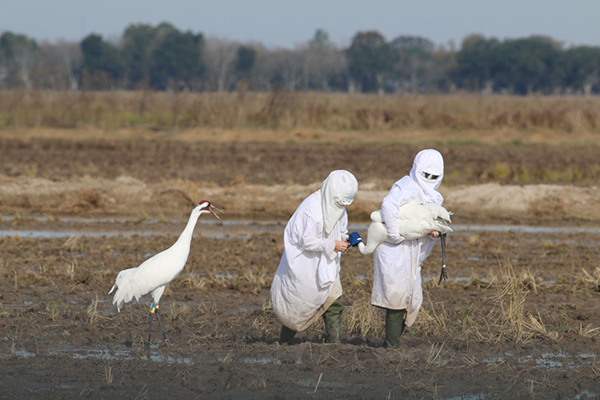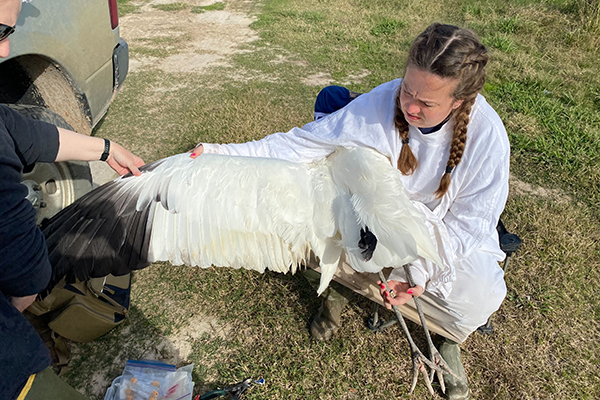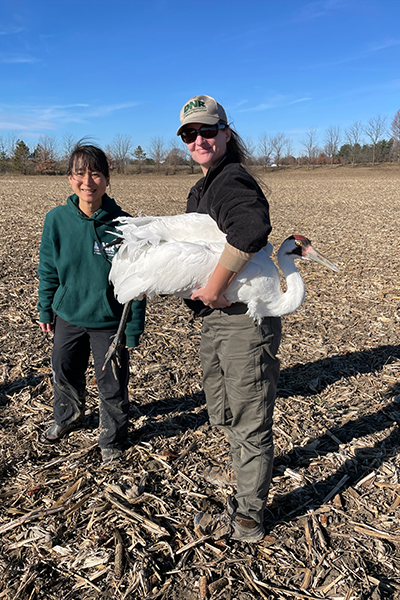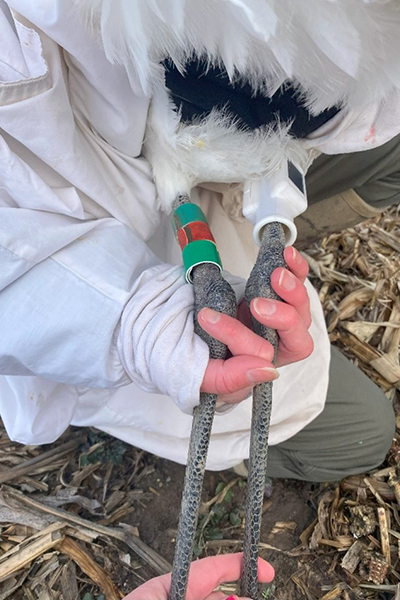
Crane conservation is many things – it is creative, resourceful, compassionate, and, above all else, it is collaborative. The International Crane Foundation is one of many partners dedicated to protecting the future of Whooping Cranes across North America, and to be effective at the work we do with our partners, it is important we continue to collaborate, share knowledge and share skills.
In December 2023, the International Crane Foundation sent our research and field team to Louisiana and Indiana to engage with our partners and share knowledge and transfer skills. The goal of these trips was to learn from and share information with our partners and colleagues about safe capture techniques, band Whooping Cranes and put out new GPS transmitters. Banding is a necessary part of our conservation effort because this is primarily how we monitor Whooping Cranes in North America. The colorful bands allow us to identify individuals by sight, and a few birds also receive radio or GPS transmitters, which will enable us to track their daily and migratory movements, gather consistent data about the habitats they are using, record their partner associations to understand future breeding efforts, document survival and more. This information will contribute to new research and inform future management efforts. Banding is also an important part of our job because it is one of the few opportunities to hold a wild crane, and we take that time to check their overall health and wellness.

Through collaboration with our partners and by working in different geographies and populations, we can learn more about how to effectively capture cranes across diverse habitats and how birds in these populations make decisions or engage with capture technologies, given what they know from their environment. We are also afforded the opportunity to work with our partners and make decisions on how we will program our tracking technology or collect data so we can have comparable data across populations to learn more about breeding birds, including their nesting behaviors and habitat selection and dispersal when raising chicks.
Our first trip in December was to Louisiana, when Hillary Thompson, our Whooping Crane Biologist, met with Eva Szyszkowski and Sara Zimorski, biologists at the Louisiana Department of Wildlife and Fisheries (LDWF), to assist them in their banding efforts before the breeding season. This population of Whooping Cranes is non-migratory, so LDWF monitors them year-round and leads their management. They are also great partners for the International Crane Foundation because Eva and Sara previously worked with Whooping Cranes in the Eastern Migratory Population, the population Hillary works with today. They offer a unique insight into the differences in capture techniques between populations and across landscapes, including landscapes we don’t encounter in Wisconsin, like rice and crawfish farms. While in Louisiana, Eva and Sara demonstrated their capture techniques, and through a joint effort with Hillary, they were a success! This season, the team banded and deployed GPS transmitters for L11-17 and L19-16, two breeding male Whooping Cranes. We learned a lot from our time in Louisiana. Most importantly, we learned about the power of partnership and what can be accomplished from working with other dedicated and knowledgeable individuals.

While Hillary was in Louisiana, Lauren Benedict, Outreach Biologist Assistant, and Stephanie Schmidt, Whooping Crane Outreach Coordinator, were collaborating with Amy Kearns and Allisyn Gillet of the Indiana Department of Natural Resources (INDNR) to monitor Whooping Cranes, explore the places they frequently forage and roost, and coordinate with the appropriate landowners to get permission for capture attempts later that month. While Amy and Allisyn’s work encompasses a variety of birds across Indiana, their support monitoring, capturing and banding Whooping Cranes is paramount to their conservation in Indiana. This state sustains the largest number of wintering Whooping Cranes in the Eastern Migratory Population.
Thanks to our team’s preparatory work and INDNR, Hillary, Stephanie and Lauren traveled to western Indiana later that month to demonstrate our capture techniques for their team. With Amy and Allisyn’s assistance, we were able to capture another two male Whooping Cranes, 16-04 and 19-09, and deploy new GPS transmitters on them to closely monitor their movements and migration back to their breeding areas at Necedah National Wildlife Refuge in Wisconsin in the spring.

This winter, we were successful in our efforts to band Whooping Cranes and deploy new GPS transmitters, but we are also incredibly grateful to have had the opportunity to work with our partners and learn from them. Having opportunities to collaborate and share knowledge is incredibly valuable for our team and will undoubtedly further our joint efforts to conserve Whooping Cranes.
We thank LDWF, INDNR, and our many partners for their collaboration and support to safeguard the future of cranes worldwide.
Story by Whooping Crane Outreach Coordinator Stephanie M. Schmidt, Whooping Crane Biologist Hillary Thompson and Outreach Biologist Assistant Lauren Benedict
